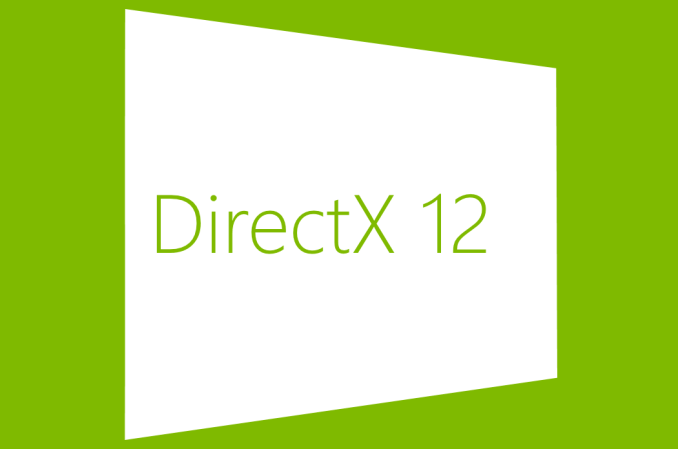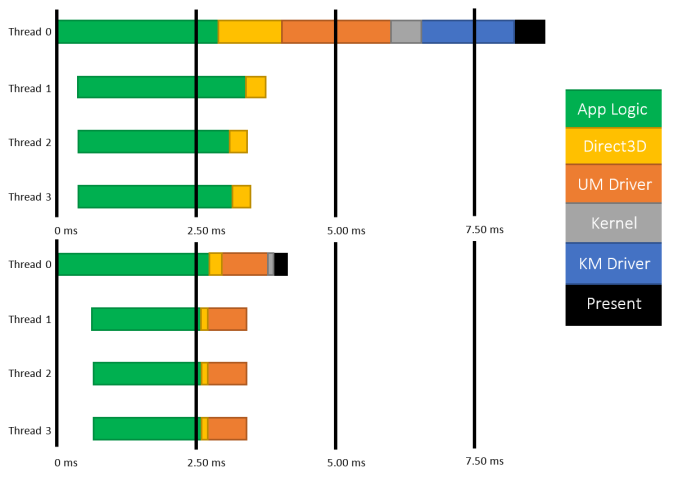The DirectX 12 Performance Preview: AMD, NVIDIA, & Star Swarm
by Ryan Smith on February 6, 2015 2:00 PM EST- Posted in
- GPUs
- AMD
- Microsoft
- NVIDIA
- DirectX 12

About a year and a half ago AMD kicked off the public half of a race to improve the state of graphics APIs. Dubbed "Mantle", AMD’s in-house API for their Radeon cards stripped away the abstraction and inefficiencies of traditional high-level APIs like DirectX 11 and OpenGL 4, and instead gave developers a means to access the GPU in a low-level, game console-like manner. The impetus: with a low-level API, engine developers could achieve better performance than with a high-level API, sometimes vastly exceeding what DirectX and OpenGL could offer.
While AMD was the first such company to publicly announce their low-level API, they were not the last. 2014 saw the announcement of APIs such as DirectX 12, OpenGL Next, and Apple’s Metal, all of which would implement similar ideas for similar performance reasons. It was a renaissance in the graphics API space after many years of slow progress, and one desperately needed to keep pace with the progress of both GPUs and CPUs.
In the PC graphics space we’ve already seen how early versions of Mantle perform, with Mantle offering some substantial boosts in performance, especially in CPU-bound scenarios. As awesome as Mantle is though, it is currently a de-facto proprietary AMD API, which means it can only be used with AMD GPUs; what about NVIDIA and Intel GPUs? For that we turn towards DirectX, Microsoft’s traditional cross-vendor API that will be making the same jump as Mantle, but using a common API for the benefit of every vendor in the Windows ecosystem.
DirectX 12 was first announced at GDC 2014, where Microsoft unveiled the existence of the new API along with their planned goals, a brief demonstration of very early code, and limited technical details about how the API would work. Since then Microsoft has been hard at work on DirectX 12 as part of the larger Windows 10 development effort, culminating in the release of the latest Windows 10 Technical Preview, Build 9926, which is shipping with an early preview version of DirectX 12.

GDC 2014 - DirectX 12 Unveiled: 3DMark 2011 CPU Time: Direct3D 11 vs. Direct3D 12
With the various pieces of Microsoft’s latest API finally coming together, today we will be taking our first look at the performance future of DirectX. The API is stabilizing, video card drivers are improving, and the first DirectX 12 application has been written; Microsoft and their partners are finally ready to show off DirectX 12. To that end, today we’ll looking at DirectX 12 through Oxide Games’ Star Swarm benchmark, our first DirectX 12 application and a true API efficiency torture test.
Does DirectX 12 bring the same kind of performance benefits we saw with Mantle? Can it resolve the CPU bottlenecking that DirectX 11 struggles with? How well does the concept of a low-level API work for a common API with disparate hardware? Let’s find out!










245 Comments
View All Comments
dakishimesan - Friday, February 6, 2015 - link
Because DirectX 10 and WDDM 2.0 are tied at the hip, and by extension tied to Windows 10, DirectX 12 will only be available under Windows 10.dakishimesan - Friday, February 6, 2015 - link
PS: great article.FlushedBubblyJock - Sunday, February 15, 2015 - link
First thoughts: R9 290X dx11=8 frames mantle=46 frames TEST= TOTAL FRAUDAlthough the difference there is what AMD told us mantle would do, only in this gigantic liefest is such hilarity achieved.
Another big industry lie-test blubbered out to the sheep at large.
0ldman79 - Monday, February 16, 2015 - link
It looks more like the people that coded that game are not very experienced and have spent far more time optimizing for future API than DX11.Christopher1 - Monday, February 16, 2015 - link
Not necessarily. DX11 no matter how 'optimized' still does not get you as close 'to the metal' as Mantle does. So yes, there can be these kinds of extreme differences in FPS.The_Countess666 - Thursday, February 19, 2015 - link
they are in fact very experienced. but they choose to do the things that previously DX11 bottleneck prevented them from doing in the past.0ldman79 - Saturday, February 21, 2015 - link
That makes sense, still not quite an apples to apples comparison in that situation, though using previously unavailable features on the new API tends to show the differences.The question still remains, will we see similar improvements on the current crop of DX11 games?
I don't think that will be the case, though I could be wrong.
Seems the gains are from multithreading, which is part of the DX11 or 11.1 spec.
RobATiOyP - Sunday, February 21, 2016 - link
Of course you won't see such a performance increase, because games have to be designed and tuned to what the platform is capable of. The console API's have allowed games, lower level access, Mantle, DX12 & Vulkan are about removing a bottleneck caused by the assumptions in DX11 & OpenGL API's which were designed when GPUs were novel items and much evolution has occured since. Those doubting the benchmark, please say why a graphics application would not want to do more draw calls per second!Fishymachine - Monday, February 16, 2015 - link
DX11 can manage up 10k draw calls, Star Storms makes 100k. Also Assasins Creed Unity makes up to 50k in case you wanted a retail game that would skyrocket in low API(there's a spot where even 2 GTX980 get 17fps)The_Countess666 - Thursday, February 19, 2015 - link
this engine was spefiically written to do all the things that previously DX11 doesn't allow game developers to do. it was designed to run headlong into every bottleneck that DX11 has.it is in fact a great demonstrations of the weaknesses of DX11.
the fact that nvidia gets higher framerates in dx11 then ATI is because they optimized the hell out of this game. that isn't viable (costs too much, far too time consuming) for every game and was purely done by nvidia for marketing, but all it really does is further illustrate the need for a low level API where the burden of optimizations is shifted to the game engine developers where it belongs, not the driver developers.